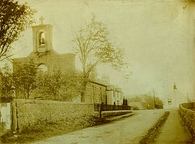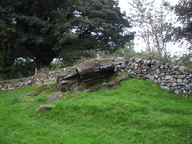Our story

1841
The Parish is
established in Houston by Rev. John Bremner. In a letter to Bishop Andrew Scott
Fr. Bremner described the property he wished to buy as: "a piece
of ground amounting to nearly five acres old Scotch measure having upon it a
good dwelling house occupied by eight different tenants and a barn and a byre
that could be turned into a church at no great expense." The
property was known as "Four Windings" but Fr. Bremner wished to
change its name to "Bishopsfield" or "Abbotsfield". The
change never happened until 2005 when Fr. Danny McLoughlin added the name of
"Abbotsfield" to the official address for the Presbytery. A case of
better late than never!

Photograph taken in 1925.
Note that the church is not painted white whereas the house is.
In 1841 the parish included Johnstone, Linwood, Bridge of Weir, Houston,
Crosslee, Bishopton and Kilmacolm.
St. Fillan's is the oldest church in the Diocese of Paisley and the house
mentioned by Fr. Bremner is still the Presbytery.
Fr. Bremner did not live in the parish but travelled from St. Mirin's in
Paisley to minister in this parish.
1846
Fr. Daniel Kenny is the first resident priest. He was only in residence a few months as he contracted typhus and died in 1847.
Our Patron
There
are two problems about our patron Saint: most of what we know is legend and it
seems that there were two Saints Fillan working in different parts of Scotland
at different times.
Traditionally St. Fillan's Festival was celebrated here on 9 January. It was still being celebrated in 1842 on that date. The other Saint Fillan's feastday was on 20 June.
Our St. Fillan is still remembered in places like Stathfillan and the River
Fillan which flows into Loch Dochart.
When Fillan was born and when he died is not know but he is believed to have
been working in the early 8th century. His main area of activity was in the
area of Strathfillan, an area extending from Tyndrum to Killin where the church
was dedicated to him.
Fillan built a church somewhere in Strathfillan but the site is now not known.
However the ruins of St. Fillan's Priory, founded by King Robert the Bruce, are
still to be seen between Tyndrum and Crianlarich.
Closer to home, just outside Houston and Bridge of Weir is Killallan, a name
which means Church of Fillan. It is believed that this has been a site of
Christian worship for many centuries.
Beside the ruins of the former Church of St. Fillan, a church which pre-dates
the Reformation, there are two things of interest: St. Fillan's Well and St.
Fillan's Seat.
St. Fillan's Well is typical of Celtic christian piety. It is recorded that
"the country-women used to bring their weak and ricketty children and
bathe them in the water, leaving some pieces of cloth as a present or offering
to the saint on the bushes. Such piety is common around "Holy Wells".
The custom continued until the end of the 17th century. St. Fillan's Seat is an earth-fast boulder. On the top is a circular hollow about 14 inches across forming a kind of seat. If you were to sit on this seat, to the right and within reach, is another smaller hollow. According to tradition, St. Fillan sat in this seat and baptised children with water from this smaller hollow.
St. Fillan's Seat
Lorem ipsum dolor sit amet, consectetur adipiscing elit. Nullam porttitor augue a turpis porttitor maximus. Nulla luctus elementum felis, sit amet condimentum lectus rutrum eget.

